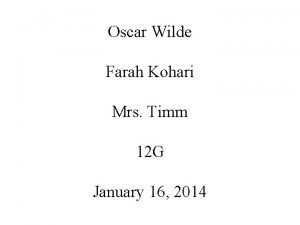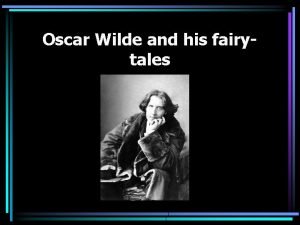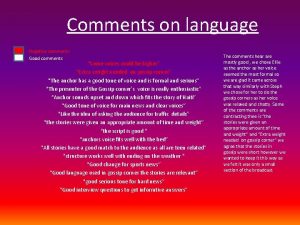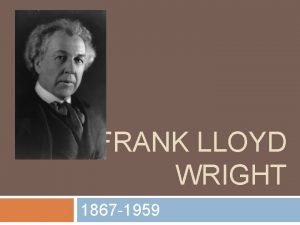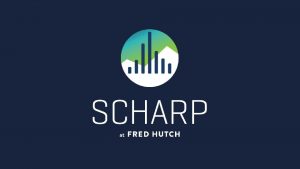Comments on Dan Lloyd Neural Correlates of Temporality






- Slides: 6

Comments on Dan Lloyd: “Neural Correlates of Temporality” Geoff Lee, Online Consciousness Conference 2010

Dan’s main claims: We experience “temporality”: we have a background conscious awareness of time passing, which is (at least) distinct from the representation of temporal stimulus features like duration and temporal frequency in attentive consciousness (the typical targets of work in cognitive science). Neural Correlates of Temporality: Dan’s analysis of FMRI images of default mode neural activity provide some evidence that activity in what he calls the “dynamic temporal network” is a neural correlate of experience of temporality. What exactly is the experience of temporality? (2) Does this data tell us anything about its neural realization? (1)

What is the experience of temporality (1)? Experience of the moving now? To many people, the passage of time consists in a constant change in which events are happening in the present, and a conscious sense of this “moving now” could be an ubiquitous feature of temporal awareness. Dan: Experience of temporality implies that perception is in “continuous flux” even “if no other stimulus property [i. e. other than the passage of time? ] is changing”. A temporal frame of reference? Just as conscious awareness may (essentially? ) involve an egocentric spatial frame, it might also involve a “now-centric” temporal frame. � This is one way of interpreting the Husserlian idea that all conscious experience has a “retentive”/ “protentive” structure.

What is the experience of temporality (2)? Conscious non-attentive temporal representation? : A conscious representation of temporal features of stimuli (like duration, ordering, frequency), that is “implicit” and “may not be a center of explicit attention”. (Perhaps best fit interpretation) � Hard to square with claim that experiencing temporality is “a structural feature of consciousness, among “those properties that are common to most or all conscious experiences””. � What sense of “implicit” is in play here? Isn’t conscious representation, even outside of attention, a paradigm of explicit representation? Similar tension between “nonsensory” and “conscious”. � It’s not true that cognitive science has mostly concerned only with the representation of duration, temporal frequency and so on in conscious attention.

Temporal Awareness in Default Mode � Assuming that neural activity in certain areas does correlate well with the duration elapsed since the brain enters default mode, what is the significance of this fact? Dan argues that: (1) This brain activity is keeping track of time. (2) It is a candidate neural correlate for conscious experience of temporality. In what sense might (1) be true? The most obvious answer is that the activity is representing the time elapsed since the brain entered default mode (i. e. since the task ended). In other cases where there is an alleged representation of a stimulus feature that a subject is not primed in advance to detect, and which is never an object of attention, there are techniques for detecting the representation, for example testing whether it has priming effects. Does Dan think any technique like this could provide further evidence for his claims?

DTN activity as implicit experience of duration This DTN representation has no clear relation to a sense of a moving now, and only an indirect relation to the idea that experience uses a temporal frame (so probably they are poor interpretations of “temporality”). Assume then that the hypothesis in question is that this DTN activity underpins conscious awareness of time elapsed since entering default mode. Question: Why think this representation is conscious? “The involved brain regions are certainly associated with conscious cognition in their other functions; it would be arbitrary to deny that this temporal mapping is not also an aspect of consciousness. ” (p. 9) � But it is very odd to think that during the whole 24 second period, the event of the perceptual task ending is something that is consciously experienced by the subject. Another question: What other analogous forms of temporal awareness might DTN activity underpin in normal experience? Would it be continuously tracking duration elapsed since many different recently perceived events, rather than just one, as in this example?





